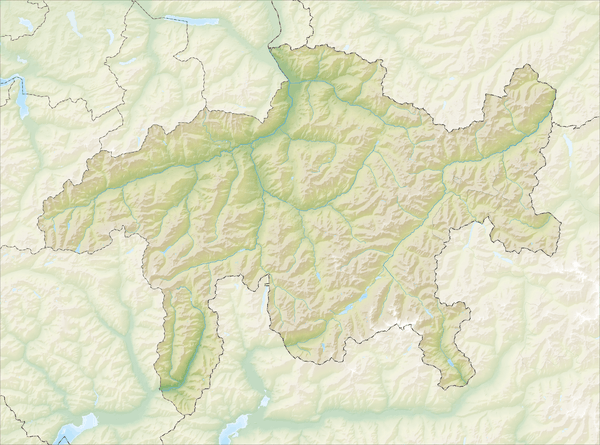Peist
Peist is a former municipality in the district of Plessur in the canton of Graubünden in Switzerland. On 1 January 2013 the former municipalities of Peist, Calfreisen, Castiel, Langwies, Lüen, Molinis and St. Peter-Pagig merged into the municipality of Arosa.[1]
Peist | |
|---|---|
 | |
 Coat of arms | |
Location of Peist 
| |
 Peist  Peist | |
| Coordinates: 46°50′N 9°40′E | |
| Country | Switzerland |
| Canton | Graubünden |
| District | Plessur |
| Area | |
| • Total | 17.93 km2 (6.92 sq mi) |
| Elevation | 1,340 m (4,400 ft) |
| Population (2010) | |
| • Total | 209 |
| • Density | 12/km2 (30/sq mi) |
| Postal code | 7029 |
| SFOS number | 3929 |
| Surrounded by | Arosa, Fideris, Furna, Jenaz, Langwies, Molinis, St. Peter-Pagig |
| Website | SFSO statistics |
History
Peist is first mentioned in 1084 as de Paiste.[2]
Geography

Before the merger, Peist had a total area of 17.9 km2 (6.9 sq mi).[3] Of this area, 57% is used for agricultural purposes, while 35.7% is forested. Of the rest of the land, 1.6% is settled (buildings or roads) and the remainder (5.7%) is non-productive (rivers, glaciers or mountains).[3]
The former municipality is located in the Schanfigg sub-district of the Plessur district. It consists of the linear village of Peist on the northern slope of the mid-Schanfigg.
Nearby is the Peist railway station, on the Chur-Arosa railway line.
Demographics
Peist had a population (as of 2010) of 209.[3] As of 2008, 4.0% of the population was made up of foreign nationals.[4] Over the last 10 years the population has decreased at a rate of -7%. Most of the population (as of 2000) speaks German (93.4%), with Portuguese being second most common ( 3.1%) and Italian being third ( 1.3%).[3]
As of 2000, the distribution of the sexes in the population was 49.3% male and 50.7% female.[5] The age distribution, as of 2000, in Peist is; 41 children or 17.9% of the population are between 0 and 9 years old and 27 teenagers or 11.8% are between 10 and 19. Of the adult population, 15 people or 6.6% of the population are between 20 and 29 years old. 43 people or 18.8% are between 30 and 39, 23 people or 10.0% are between 40 and 49, and 21 people or 9.2% are between 50 and 59. The senior population distribution is 35 people or 15.3% of the population are between 60 and 69 years old, 17 people or 7.4% are between 70 and 79, there are 7 people or 3.1% who are between 80 and 89.[4]
In the 2007 federal election the most popular party was the SVP which received 53.2% of the vote. The next three most popular parties were the SP (24.8%), the FDP (11.1%) and the CVP (7.2%).[3]
In Peist about 69.4% of the population (between age 25-64) have completed either non-mandatory upper secondary education or additional higher education (either university or a Fachhochschule).[3]
Peist has an unemployment rate of 2.54%. As of 2005, there were 25 people employed in the primary economic sector and about 11 businesses involved in this sector. 39 people are employed in the secondary sector and there are 5 businesses in this sector. 8 people are employed in the tertiary sector, with 5 businesses in this sector.[3]
The historical population is given in the following table:[2]
| year | population |
|---|---|
| 1780 | 312 |
| 1850 | 236 |
| 1900 | 160 |
| 1950 | 180 |
| 2000 | 229 |
References
- Nomenklaturen – Amtliches Gemeindeverzeichnis der Schweiz Archived 2015-11-13 at the Wayback Machine (in German) accessed 9 February 2013
- Peist in German, French and Italian in the online Historical Dictionary of Switzerland.
- Swiss Federal Statistical Office accessed 11 February 2013
- Graubunden Population Statistics Archived 2009-08-27 at the Wayback Machine (in German) accessed 21 September 2009
- Graubunden in Numbers Archived 2009-09-24 at the Wayback Machine (in German) accessed 21 September 2009
| Wikimedia Commons has media related to Peist. |
External links
- Peist in German, French and Italian in the online Historical Dictionary of Switzerland.